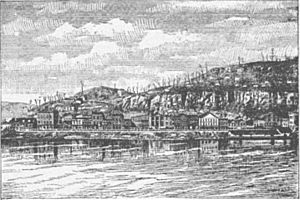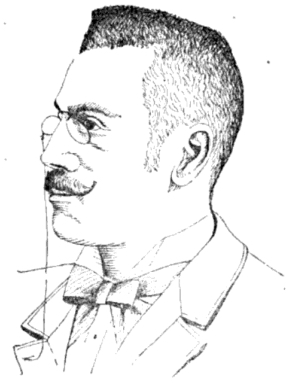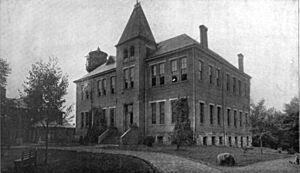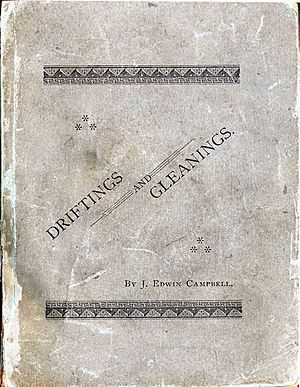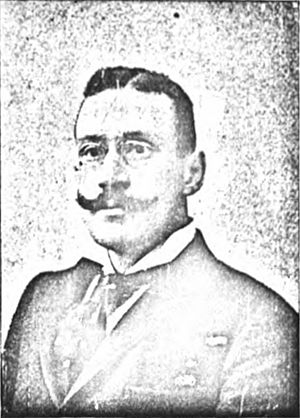James Edwin Campbell (poet) facts for kids
Quick facts for kids
James Edwin Campbell
|
|
|---|---|
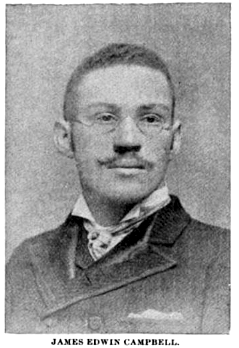
Portrait from Local and National Poets of America with Interesting Biographical Sketches (1892)
|
|
| 1st President of West Virginia State University |
|
| In office 1892–1894 |
|
| Preceded by | Office established |
| Succeeded by | John H. Hill |
| Principal of Langston Academy | |
| In office 1891–1892 |
|
| Preceded by | Luta Freeman |
| Succeeded by | Ida Wilson |
| Personal details | |
| Born | September 28, 1867 Pomeroy, Ohio, United States |
| Died | January 26, 1896 (aged 28) Pomeroy, Ohio, United States |
| Spouse | Mary Lewis Champ-Campbell |
| Profession | Educator, school administrator, newspaper editor, poet, and essayist |
| Signature |  |
James Edwin Campbell (September 28, 1867 – January 26, 1896) was an important American educator, school leader, newspaper editor, and a talented poet and writer. He made history as the first principal of the West Virginia Colored Institute. This school is known today as West Virginia State University. He led the institute from 1892 to 1894.
Campbell was born in 1867 in Pomeroy, Ohio. He finished his high school studies at Pomeroy Academy in 1884. His first job was teaching in Buck Ridge, Ohio, for two years. Later, he moved to West Virginia. There, he became the editor for newspapers like The Pioneer and West Virginia Enterprise. From 1891 to 1892, he was the principal of the Point Pleasant Colored School. This school was later renamed Langston Academy.
In 1892, Campbell was chosen to be the first principal of the West Virginia Colored Institute. He served in this role until 1894. He was recognized for his work with an honorary degree from Shaw University in 1893. Campbell showed a gift for writing poetry and stories from a young age. He continued to write throughout his life.
His first book, Driftings and Gleanings, was published in 1887. It was a collection of poems and essays written in standard American English. After leaving the West Virginia Colored Institute, Campbell moved to Chicago in 1895. He became a writer for the Chicago Times-Herald newspaper. He also helped publish Four O'Clock Magazine. In 1895, he released his second book, Echoes from the Cabin and Elsewhere. This book featured poems written in the southern African-American dialect. Campbell was one of the first African-American poets to write in this unique dialect.
James Edwin Campbell passed away in Pomeroy, Ohio, in 1896. He was only 28 years old. Today, West Virginia State University honors him with Campbell Hall and the Campbell Conference Center.
Contents
Early Life and Learning
James Edwin Campbell was born on September 28, 1867. His birthplace was in the Kerr's Run area of Pomeroy, Ohio. His parents were James Edward Campbell and Aletha "Letha" Esther Starks Campbell. Both of his parents were born in Virginia (now West Virginia) before the American Civil War. James had two older brothers, Charles William and John C. Campbell.
He grew up in Kerr's Run, which was part of Pomeroy's First Ward. Campbell attended Kerr's Run Colored School for his elementary education. He then went on to Pomeroy Academy for high school. He graduated from Pomeroy Academy in 1884.
Starting a Career in Education
Campbell began his career as a teacher in Buck Ridge, Ohio. He taught there for two years. He also spent some time teaching in Rutland, Ohio. Campbell believed that West Virginia offered good chances for African Americans to succeed. This was because of the growing coal and oil industries.
He was hired by Christopher Payne to be the editor of Payne's newspaper, The Pioneer. In 1887, Campbell took over as editor of the West Virginia Enterprise in Charleston. The Wheeling Daily Intelligencer newspaper described Campbell as "an educated young Ohioan" who was "highly spoken of."
Campbell was also a talented public speaker. In May 1889, he gave a speech called "Race Antagonism" in Wheeling. The newspaper noted his "natural gift of oratory." It said his speech was "brimfull of eloquence" and "instructive." The money raised from his lecture helped the church buy new books for its Sunday school library.
Leading Langston Academy
In 1891, the Point Pleasant Board of Education chose Campbell as the principal of the Point Pleasant Colored School. He took over from Luta Freeman. Under Campbell's leadership, the school moved to a new, larger building. This building was a two-story brick structure with four rooms. It had been used by a white school before.
After this move, the school was renamed Langston Academy. It was named after John Mercer Langston, a famous African-American educator. Campbell served as principal of Langston Academy until 1892. Ida Wilson then became the principal after him.
First Principal of West Virginia Colored Institute
On April 1, 1892, James Edwin Campbell was chosen as the first principal of the West Virginia Colored Institute. This important decision was made by the institute's Board of Regents. The institute was located in Farm, West Virginia. This area is now known as Institute and is near Charleston.
The West Virginia Colored Institute was founded in 1891. Its purpose was to provide education in farming and mechanical skills for African Americans in West Virginia. This was made possible by the Morrill Act of 1890.
Before Campbell became principal, the West Virginia Legislature set aside $10,000 to buy land for the school. A committee bought 30 acres along the Kanawha River. This land was near the community of Farm. The institute's first building was finished in April 1892. Campbell officially opened the institute on April 26, 1892.
The school started its first classes on May 3, 1892, with 20 students. The early courses were like a high school education. They included agriculture, gardening, mechanical arts, home economics, job training, and teacher preparation. Campbell asked Booker T. Washington to suggest a graduate from Tuskegee Institute to be the Superintendent of Mechanics. James M. Canty was hired for this role and arrived in January 1893.
By June 1893, the school had a small team of teachers. Campbell was the principal and taught mathematics. Byrd Prillerman taught English. Canty taught mechanics. Campbell's wife, Mary Lewis Champ-Campbell, taught music, painting, and drawing. In 1893, Campbell received an honorary degree from Shaw University.
As principal, Campbell helped African-American coal miners in West Virginia. He guided them on how to get an education for their children. Campbell resigned in 1894. John H. Hill took over as principal. During his time at the institute, Campbell lived in Fleming Hall.
West Virginia Teachers' Association
In 1891, Campbell and other African-American educators in West Virginia started the West Virginia Teachers' Association. Their goal was to encourage interest in their work. They also wanted to promote cooperation among African-American teachers across the state. The association aimed "to improve the teaching profession and promote education in West Virginia."
Campbell spoke at the association's second annual meeting in Parkersburg in 1892. At the third annual meeting in Parkersburg in 1893, Campbell was named president of the association.
Writing and Poetry
From a young age, Campbell showed a natural talent for writing poems and stories. Early in his writing journey, he wrote simple poems in the African-American dialect. Some of these poems were published in newspapers and magazines.
Campbell continued to write poetry and stories in his free time. This was while he worked as a teacher and school leader. In 1887, he published his first book, Driftings and Gleanings. This book was a collection of poems and essays written in standard American English.
After leaving the West Virginia Colored Institute, Campbell moved to Chicago in the summer of 1895. He became a staff writer for the Chicago Times-Herald newspaper. He reportedly told a friend, "Life is too uneventful in a little village. I want to get out into the great world." Historian Wilhelmena S. Robinson believes Campbell's work as a newsman was his most important contribution to literature.
Campbell kept publishing his own poems and articles. He also took part in a group that published Four O'Clock Magazine. In 1895, he released his second book, Echoes from the Cabin and Elsewhere. This book was a collection of poems written in the southern African-American dialect. Richard Linthicum, an editor, wrote the introduction. He said Campbell had "caught the true spirit" of African Americans from the Antebellum South. The Poetry Foundation praises this book. It calls it "one of the finest collections of dialect poems of the 19th century." It mixes realism and folk wisdom with real, rhythmic dialect.
Personal Life
Campbell married Mary Lewis Champ on August 4, 1891. She was born on July 12, 1868. Mary was also a poet and an educator. She taught in Wheeling for one year before marrying Campbell.
Death and Lasting Impact
Campbell wrote his last poem, "Homesick," on December 7, 1895. It was published in The Chicago Conservator. The poem expressed his wish for the "quiet of the home place." While visiting his family in Pomeroy, Ohio, for Christmas, Campbell became ill. He had symptoms of a common cold and then a fever. He died from typhoid pneumonia on January 26, 1896. He was at his family's home. He was survived by his parents and his wife. Campbell was buried at Beech Grove Cemetery in Pomeroy.
After his death, his wife taught in Pomeroy. She then taught at Kentucky State Normal School for Colored Persons from 1902 to 1903. She later moved to St. Louis, where she passed away in 1909.
Campbell's Legacy
James Edwin Campbell was one of the first African-American poets to write in the African-American dialect. While Paul Laurence Dunbar is famous for popularizing this style, Campbell published his dialect poetry even earlier.
Author and educator J. Saunders Redding said that Campbell's dialect was very close to how people actually spoke. He noted that Campbell's "ear alone dictated his language." Civil rights activist James Weldon Johnson described Campbell's dialect as being similar to Gullah or West Indian dialects. Historian Jean Wagner believed Campbell had his "own highly original talent." Wagner also said Campbell showed a strong "racial consciousness" among Black people. Actor Richard Berry Harrison used Campbell's poems in his dramatic readings.
In 2007, a historical marker honoring Campbell was placed in Pomeroy. This was done by the Meigs County Historical Society and the Ohio Historical Society. In 1973, West Virginia State College named its vocational building Campbell Hall to honor him. When the college turned its old home economics cottage into a conference center, they named it the Campbell Conference Center. In 2019, a new marker was unveiled at the site of Campbell's old school, Kerr's Run Colored School. The ceremony ended with a reading from one of Campbell's books.
Campbell was played by actor George Dale Jr. in the 2020 film River of Hope. This movie tells the story of Samuel I. Cabell and his wife Mary Barnes Cabell. It also shows how their children helped to create West Virginia State University.
Selected Works
Poems
- "A Night in June"
- "Mobile-Buck"
- "Ol' Doc' Hyar"
- "The Gobble-un Gets Him"


